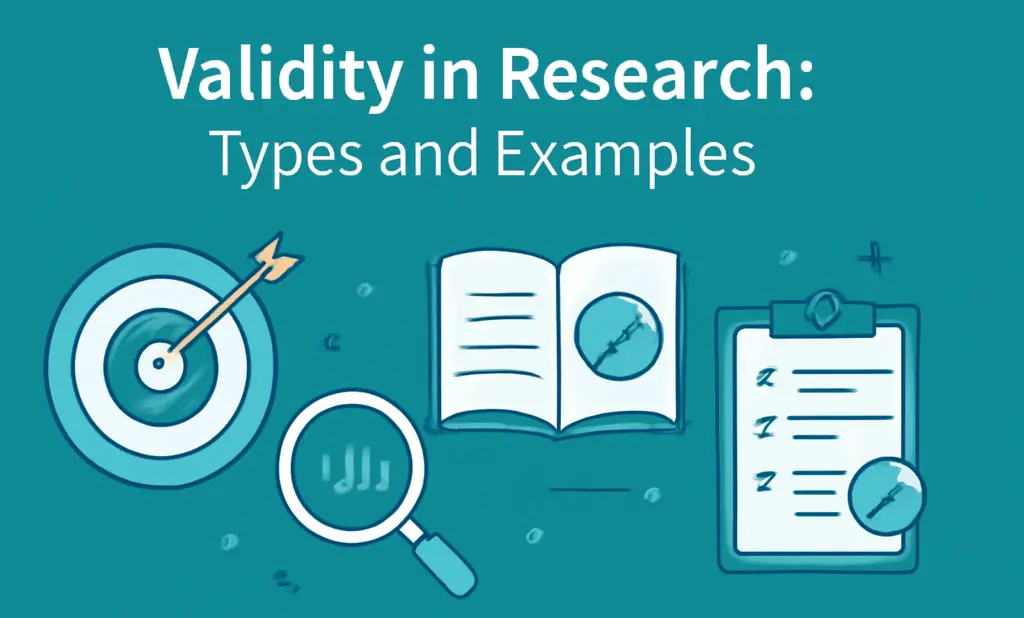Validity in Research
Validity in Research is an essential concern that prevails at every step of the research process. Validity, in its most basic sense, pertains to the appropriateness of every stage in the research process. However, the idea of validity is more closely linked to measurement procedures.
When it comes to the measurement procedure, validity in research refers to the instrument’s ability to measure its intended target accurately. In other words, validity in research refers to how accurately a measuring instrument reflects the actual differences among the individuals being tested. In the field of research, the notion of validity includes the overall appropriateness and accuracy of the research process.
Example: Imagine administering a test to assess a trait like problem-solving. High validity indicates that the test accurately measures problem-solving ability. Here, the test yields accurate findings that match the trait it aims to measure.
Types of Validity
There are some basic types of validity in research which are discussed here;
Face Validity
Face validity is the procedure that allows you to provide a rationale for a question or item’s inclusion in a research instrument by connecting it to the study’s objectives. The establishment of this link demonstrates the validity of the instrument. The stronger the relationship there is, the more face validity of the instrument. Face validity refers to the extent to which an instrument appears to be logically appropriate in measuring the intended content (Kumar, 2005).
Example: Consider a loneliness research. The researchers created a survey asking: How often do you socialize with friends and family? At first sight, this question looks related to loneliness. Someone examining the survey would likely agree that it measures what it’s supposed to. This has good face validity.
Content Validity
It is important to ensure that each question in the study aligns with its objectives to establish face validity. Additionally, it is important to thoroughly assess if the questions have adequately addressed all the intended areas of the study. Analyzing the questions of a research instrument to determine how well it covers the areas being studied is known as assessing the content validity of the instrument.
Content validity is closely tied to ensuring a representative sample for the study. It typically aims to assess if all available methods were utilised (Hill & Willoughby, 2005). Content validity in research refers to the degree to which a measuring instrument effectively covers the subject matter being investigated. If the instrument contains a representative sample of the universe, then the content validity is considered to be strong.

The determination is primarily based on personal judgment and instinct. Another approach is to involve a group of individuals who can assess the extent to which the measuring instrument meets the required standards. However, assessing through numerical methods is not possible.
Example: Consider creating a history chapter test. The test has good content validity if it covers important events, dates, and causes. If it only lists dates and neglects causation, its content validity may be doubtful.
Construct Validity
This is the most complex and abstract. A measure is considered to have construct validity when it confirms and predicts correlations with other theoretical propositions, indicating its accuracy and reliability. Construct validity evaluates whether the variables being tested align with your theory.
Construct validity in research is typically established by comparing the test to other tests that assess similar qualities, in order to determine the degree of correlation between the two measures. If measurements on our developed scale align with these other propositions in a predicted manner, it can be believed that there is some construct validity.
Example: A researcher creates an IQ test. Comparing the test to other intelligence tests for correlation ensures construct validity. This is used to confirm that the test measures intelligence.
Predictive Validity
The accuracy of predictions is determined by how well an instrument is able to predict an outcome. The greater the accuracy of the projections, the stronger the instrument’s predictive validity. It pertains to our capacity to predict a certain result or assess the presence of a particular state.
This form of validity in research demonstrates the effectiveness of measures used for certain empirical estimation purposes. Take IQ tests, for instance. They were initially created to predict academic achievement. The scores on these tests are closely linked to future academic achievements, allowing us to evaluate their ability to predict future success.
Concurrent Validity
When assessing the effectiveness of a research instrument by comparing it to an observable criterion or credible findings, it is referred to as concurrent validity. It involves comparing the results of your instrument with those obtained from another widely recognized source. Concurrent validity is evaluated based on the level of agreement between an instrument and a second assessment conducted at the same time.
Example: A researcher creates a depression test. A validated depression test like the Beck Depression Inventory is compared to the new test to ensure concurrent validity. If the new test scores closely match the previous test, it is valid because it measures the same concept.
Criterion-related Validity
However, criterion-related validity includes predictive and concurrent validity. It measures the degree to which a test or measure is related to a given criterion or outcome, whether concurrently or predictively. Criterion-related validity, which includes concurrent validity, includes both, such as, how a measure predicts future outcomes and how it compares to other measures of the same concept that are already available.
To assess concurrent validity, a study may compare depression survey results to current symptoms. In short, Predictive validity in research focuses on the future, while concurrent validity looks to the present.
External Validity

External validity in research refers to the ability to generalize the findings of a study to different conditions, individuals, settings, and measurements. External validity is all about how well the findings of a study can be generalized to other similar situations in the field (Brink 1996).
Example: A study examined how using mobile phones before bedtime affected sleep quality. The use of electronic devices before bed is tested in a sleep lab with 100 individuals. The results reveal that blue screens 2 hours before bedtime make sleep harder.
This study has good external validity since it may be applied to various persons, settings, and measures. The findings can inform public health policies and recommendations to improve sleep quality of a wider population of all ages, cultures, and surroundings.






